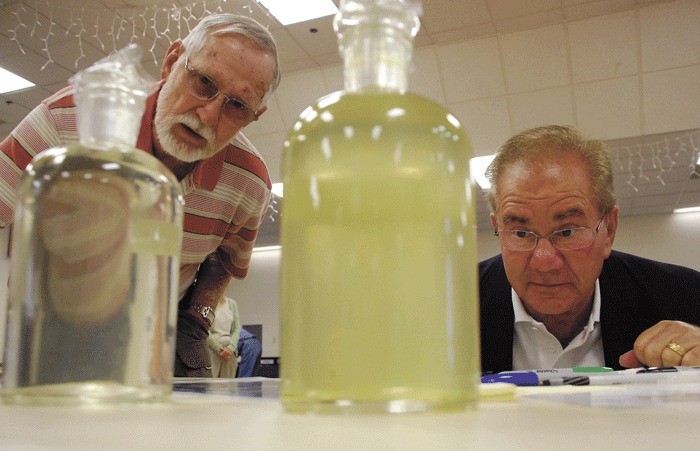Can composting toilets really play a large role in Oak Harbor’s future?
That was one of the questions that came up during the third installment of a series of public meetings concerning the city’s proposed new wastewater treatment plant. People also quizzed engineers with concerns ranging in topic from the environment and water reuse to cost and long term growth.
“It was just what we were looking for,” City Engineer Eric Johnston said.
The meeting was held at the Elks Lodge Wednesday evening, and like the two that preceded it, it was designed to garner public input on a plan to replace Oak Harbor’s two existing wastewater treatment plants with a new and modern facility by 2017.
Not including the handful of city employees, representatives, and elected officials in attendance, the meeting drew a healthy crowd of about 40 people.
There to start things off was Brian Matson, a partner with Corollo. The national engineering firm was hired this past August at a cost of $1.09 million to create a preliminary engineering and facilities plan for the proposed treatment plant.
Largely repeating the presentation he gave to the city council last month, Matson went over the firm’s work so far and how the number of proposed sites was whittled down from more than 25 to just three finalists.
While no decisions have been made, the firm is suggesting the new facility be built at either Windjammer Park, the old City Shops at the northern end of City Beach Street, or Navy property located behind the existing lagoon site on Crescent Harbor.
According to Matson and the firm’s findings, there a benefits and drawbacks associated with each site. For example, while Windjammer Park will likely be the cheapest of the three to build it has proved the least popular with the public and decision-makers. The existing sewer plant has been an eyesore there for years.
“There’s no perfect alternative,” Matson said. “I wish there was. It would make my job a lot easier.”
Cost of the facility was originally estimated at about $70 million but has since ballooned to between $90 million and $95 million. The range is dependent on the site location and type of technology employed.
Rising costs, along with ecological concerns, led to conversation about composting toilets. Oak Harbor resident Michael and Netsah Zylinsky claimed that they have the potential to improve water quality and save taxpayers millions.
They also asked if engineers are considering possibilities for water reuse, such as using effluent for agricultural purposes rather than just discharging it into Puget Sound.
Island County Commissioner Angie Homola, who was also present, asked about water reuse as well though her question was more technical. She inquired whether engineers knew what types of reuse were possible at each site along with recharge rates.
Addressing both questions, Johnston said water reuse is being considered for all three sites, but due to the specifics of each location, the type of reuse employed at each would be different.
For example, a facility at Windjammer Park might focus on irrigation at local ball-fields while aquifer recharge might be more appropriate at Crescent Harbor. Once a final site is nailed down, engineers will begin to focus on the possibilities more closely.
As for composting toilets, Johnston agreed they have useful applications and could save water. However, even if everyone in town had one, the city would still need a wastewater treatment facility.
Most of the water the existing plants treat comes from other household sources, such as showers, dishwashers and washing machines, he said.
The more conservative crowd focused their questions on issues of cost and long range planning. Oak Harbor resident John Triplett asked if the facility will be able to handle the city’s future needs.
Johnston said the plant will be initially designed to handle about 3.5 million gallons of water a day. However, it’s being designed in such a way that it could be expanded and eventually treat up to 6 million gallons a day.
Finally, City Councilman Rick Almberg addressed the issue of cost. Last year, the council adopted a schedule to increase utility rates over the next seven years as a means of paying for the facility. But, it was designed around a $70 million price tag and Almberg asked why engineers are now looking at a more expensive facility.
Johnston said the type of plants under consideration haven’t changed but the price has turned out more than anticipated. While they are trying to keep costs down, the city needs a new facility and it’s going to be expensive.
“It’s not going to be cheap,” he said.
After the meeting, Johnston explained that the current cost estimates should be viewed as a tool for comparison between sites rather than an absolute final cost. It’s still early in the process and there will be lots of time later, after a final site is selected, to looks at ways of reducing the total price.



